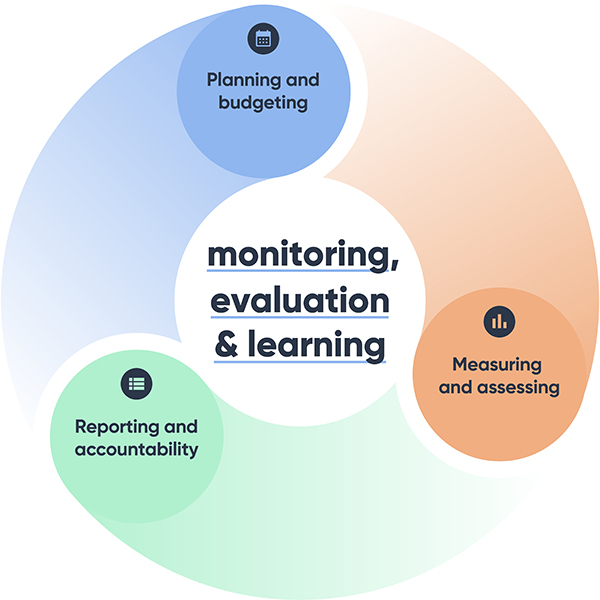On this page
Evaluation helps to understand, drive and demonstrate the performance of government programs and activities.
It can also help to confirm that expected results are being achieved and risks are being managed.
Good practice
It is good practice to:
- plan how government activities and programs will be monitored and evaluated from the start
- collect robust performance information that supports continuous improvement, risk management, accountability and decision‑making at all policy stages.
Meet policy and legislative requirements
Commonwealth entities and companies are required to:
- measure, assess and report on performance under the Commonwealth resource management and performance frameworks, established under the Public Governance, Performance and Accountability Act 2013 (PGPA Act) and associated instruments and policies.
- ensure implementation and evaluation planning are properly addressed in proposals considered in the Budget and Cabinet processes.
- use monitoring and evaluation to generate data and robust evidence to drive continuous improvement in accordance with relevant whole‑of‑government policies and frameworks (for example, regulatory, risk management, charging and grants policy frameworks).
Benefits for government, policymakers, and community
Evaluation can help you:
- understand a current need or the extent of an issue and best practice to respond
- clarify and strengthen a program's design and approach
- demonstrate your activity or program’s success or progress
- track the delivery of government priorities
- learn how well things are working and why
- better manage risks by periodically reviewing the effectiveness of risk management arrangements
- ensure processes are in place to identify and fix off‑track initiatives
- communicate information to stakeholders about the impacts of your activity or program
- meet your obligations under relevant Commonwealth legislation and policy.
Effective monitoring and evaluation provides assurance that government activities and programs are delivering outcomes as intended and that performance is tracked. It allows for corrections to occur, while informing future policy and program design.
The evidence gained from monitoring and evaluation allows Commonwealth entities and companies to adapt to changing economic and policy environments and make judgements that support government decision‑making.
Different benefits
Properly planned and executed, the appropriate use of evaluation can result in benefits for the government, entities, Commonwealth officials, and the community. Some examples of the potential benefits are detailed below:
| Beneficiary | Potential benefits of the appropriate evaluation use |
|---|---|
| Government |
|
| Entities |
|
| Commonwealth officials |
|
| Community |
|
Adapted from ACT Government Evaluation Policy and Guidelines, page 5.
Different policy cycle stages
Effective monitoring and evaluation is important at all stages of the policy development and implementation cycle. From early design and decision‑making in the Budget and Cabinet processes, to the ongoing measurement and assessment of activities and programs across performance reporting cycles.
It helps to provide assurance to accountable authorities (that is, heads of departments and agencies) and government that activities and programs are delivering the intended benefits to the Australian community.

Considerations
- Planning and budgeting - planning how a government program or activity will be monitored and evaluated in the early policy design stages helps to establish robust, efficient, ethical and culturally appropriate ways to measure and assess whether anticipated benefits for Australians are being achieved. It allows baseline data and information to be established from the beginning, and provides opportunities to consider whether data collection can be built into administrative systems to reduce costs and increase coverage. Past evaluation findings are also useful in justifying the need for, and design of, new policy proposals and programs. It is also important to consider the resources needed to evaluate a program or activity as part of the new policy proposal process.
- Implementing, measuring and assessing – the robust and transparent measurement and assessment of government activities and programs is an ongoing and critical part of good performance management and accountability. Performance information typically draws on multiple sources of evidence, including evaluations, to assess how well government activities and programs are achieving their objectives, and to support accountability, continuous improvement and decision‑making at different levels.
- Reporting and being accountable – the purpose of reporting is to communicate information to relevant stakeholders that holds people accountable for the things they are responsible for. It also supports learning and evidence‑based decision‑making. In the Commonwealth, performance information is mainly communicated to the government, the Parliament, managers within an entity, key stakeholders and the Australian community. Evaluation can complement, or enhance, an entity's regular performance monitoring and reporting activities by providing a robust evidence‑base to track the delivery of Government priorities, assess the extent to which expected benefits are being achieved, and identify when initiatives are off track.
Commonwealth evaluation requirements
In the Commonwealth, there are many of whole‑of‑government legislative frameworks, policies and processes in place that require monitoring and evaluation to be considered at all stages of policy design, development and delivery.
Public governance, performance and accountability framework
- Commonwealth Resource Management Framework
- Commonwealth Performance Framework
- Australian Government Charging Framework
- Commonwealth Grants Policy Framework
- Commonwealth Risk Management Policy
Cabinet and Budget processes
- Implementation
- Budget Process
- Assurance Framework for Digital and ICT Investments
- Assurance Reviews
- Risk Assessments
- Policy Impact Analysis
Related whole‑of‑government frameworks, policies and guidance
- Indigenous Evaluation Strategy
- AIATSIS Code of Ethics for Aboriginal and Torres Strait Islander Research
- Indigenous Advancement Strategy Evaluation Framework
- Regulator Performance
- APS Craft: Strategy, Policy and Evaluation

